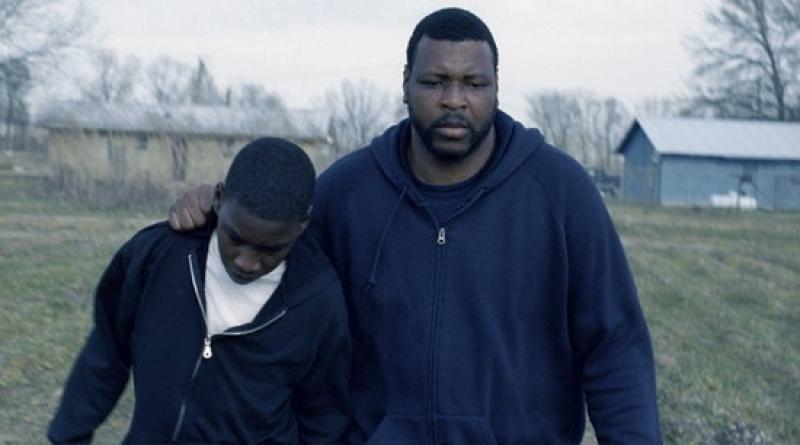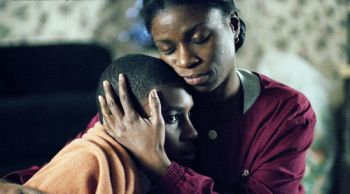Ballast | reviews, news & interviews
Ballast
Ballast
Lance Hammer's powerful debut depicts black rural American poverty

The opening images have mighty symbolic heft. A boy dashing across a blasted wintry field compels a flock of birds to take to the air, hundreds if not thousands of them blackening sky and screen, squawking and flapping in cacophonous unison. Cut to a freight train, truck after truck, thundering under clouds across the barren land. Cut to two plastic deer parked outside a wooden prefab.
Ballast, from first-time director Lance Hammer, is a work of quiet rage – for the first 15 minutes, extremely quiet. This is a place where people, trapped in a private space by loneliness and poverty, don’t tend to open their mouths much. A white man knocks on a door and pushes into a house, where he finds two heavy-set black men, one dead in bed, the other catatonic with grief. No sooner has the intruder called for an ambulance than the other man has dashed outside and shot himself. Unsuccessfully.
In rapid cuts, he is restored to health in the same noisy hospital where his brother’s body lies mute on the mortuary slab, then sent home to resume his moribund existence. Lawrence’s home – it’s as much as the narrative can do to give him a name - is one of a pair of houses on the edge of a field in the Mississippi Delta. Cars roar by incuriously. His only visitor is the boy we glimpsed in that opening sequence, now pointing his own pistol at him and demanding money. It emerges that he is sticking up his uncle, that the dead man was his estranged father, and that he is hock to drug runners who are punitive when reimbursement fails to materialise.
Watch the opening montage in the trailer for Ballast
And so, one jigsaw piece at a time, a portrait of a fractured family – and beyond it, a wounded society – emerges. Marlee, a single mother abandoned by the father of her child, scrubs latrines for a living, every day leaving her friendless son James to get up to no good. When she loses her job and James is physically threatened, she goes into hiding in the empty house next door to Lawrence who, being her ex-husband's twin, brings out her inner hellcat.
Ballast was shot in 2006 and shown at Sundance as far back as 2008 and, while it has been picking up rave notices on the festival circuit ever since, it has waited this long for a UK release on grounds that seem inexplicable. Hammer, who wrote, directed and most importantly edited Ballast down to its barest bones, is a born poet who works carefully with elemental clay. He has a small budget but a big imagination and bigger empathy. The three main characters, occupants of a pitiless rain-lashed hinterland on the edge of the bayou, easily bear the weight of a mythic story that feels much greater than the scope of small lives narrowed by economic disadvantage.
 What is all the more extraordinary is that they are played by non-professional actors. There isn’t a trace of mannerism or inauthenticity in either Micheal J Smith Snr’s Lawrence, mumbling and heavy with the lassitude of sorrow, or JimMyron Ross’s withdrawn, poker-faced James. It’s no surprise that, as Marlee, Tarra Riggs (pictured with Ross) is the one who has gone on to act professionally: hers is the kinetic corner of this stricken triangle, the catalyst fired up by the all-American spirit of entrepreneurial self-improvement. Her performance even has the odd show-pony moment you could actually stick on a showreel.
What is all the more extraordinary is that they are played by non-professional actors. There isn’t a trace of mannerism or inauthenticity in either Micheal J Smith Snr’s Lawrence, mumbling and heavy with the lassitude of sorrow, or JimMyron Ross’s withdrawn, poker-faced James. It’s no surprise that, as Marlee, Tarra Riggs (pictured with Ross) is the one who has gone on to act professionally: hers is the kinetic corner of this stricken triangle, the catalyst fired up by the all-American spirit of entrepreneurial self-improvement. Her performance even has the odd show-pony moment you could actually stick on a showreel.
The film has some thematic overlap with Winter’s Bone, another snapshot of the barely peopled moral wasteland that is backwoods America. There are drugs but somehow there is also decency and the possibility of redemption, although in the first hour of Ballast you’d be hard pressed to work out where. Having established an atmosphere of brutal Hardyesque sadism in which characters are trapped by remorseless fate, the film sets about looking for scraps of hope in the rubble of derelict lives. The ending is tentative, open-ended, antepenultimate. But it hints at the possibility of a healing major chord (although it goes without saying that there is nothing so ornamental as a soundtrack).
Occasionally you do wonder: is the film too still, too introverted, too in love with its unembellished austerity? But Hammer's aesthetic choices, matched by the sparse, washed-out camerawork of Lol Crawley, stem from honesty. Ballast is about people who have nothing, who subsist - as the title hints - below the waterline. The source of its raw power puts you in mind of a catchphrase that once helped a champion of the downtrodden into the White House. It's the economy, stupid.
Explore topics
Share this article
The future of Arts Journalism
You can stop theartsdesk.com closing!
We urgently need financing to survive. Our fundraising drive has thus far raised £49,000 but we need to reach £100,000 or we will be forced to close. Please contribute here: https://gofund.me/c3f6033d
And if you can forward this information to anyone who might assist, we’d be grateful.

Subscribe to theartsdesk.com
Thank you for continuing to read our work on theartsdesk.com. For unlimited access to every article in its entirety, including our archive of more than 15,000 pieces, we're asking for £5 per month or £40 per year. We feel it's a very good deal, and hope you do too.
To take a subscription now simply click here.
And if you're looking for that extra gift for a friend or family member, why not treat them to a theartsdesk.com gift subscription?
more Film
 Steve review - educator in crisis
Cillian Murphy excels as a troubled headmaster working with delinquent boys
Steve review - educator in crisis
Cillian Murphy excels as a troubled headmaster working with delinquent boys
 Can I get a Witness? review - time to die before you get old
Ann Marie Fleming directs Sandra Oh in dystopian fantasy that fails to ignite
Can I get a Witness? review - time to die before you get old
Ann Marie Fleming directs Sandra Oh in dystopian fantasy that fails to ignite
 Happyend review - the kids are never alright
In this futuristic blackboard jungle everything is a bit too manicured
Happyend review - the kids are never alright
In this futuristic blackboard jungle everything is a bit too manicured
 Robert Redford (1936-2025)
The star was more admired within the screen trade than by the critics
Robert Redford (1936-2025)
The star was more admired within the screen trade than by the critics
 Blu-ray: The Sons of Great Bear
DEFA's first 'Red Western': a revisionist take on colonial expansion
Blu-ray: The Sons of Great Bear
DEFA's first 'Red Western': a revisionist take on colonial expansion
 Spinal Tap II: The End Continues review - comedy rock band fails to revive past glories
Belated satirical sequel runs out of gas
Spinal Tap II: The End Continues review - comedy rock band fails to revive past glories
Belated satirical sequel runs out of gas
 Downton Abbey: The Grand Finale review - an attemptedly elegiac final chapter haunted by its past
Noel Coward is a welcome visitor to the insular world of the hit series
Downton Abbey: The Grand Finale review - an attemptedly elegiac final chapter haunted by its past
Noel Coward is a welcome visitor to the insular world of the hit series
 Islands review - sunshine noir serves an ace
Sam Riley is the holiday resort tennis pro in over his head
Islands review - sunshine noir serves an ace
Sam Riley is the holiday resort tennis pro in over his head
 theartsdesk Q&A: actor Sam Riley on playing a washed-up loner in the thriller 'Islands'
The actor discusses his love of self-destructive characters and the problem with fame
theartsdesk Q&A: actor Sam Riley on playing a washed-up loner in the thriller 'Islands'
The actor discusses his love of self-destructive characters and the problem with fame
 Honey Don’t! review - film noir in the bright sun
A Coen brother with a blood-simple gumshoe caper
Honey Don’t! review - film noir in the bright sun
A Coen brother with a blood-simple gumshoe caper
 The Courageous review - Ophélia Kolb excels as a single mother on the edge
Jasmin Gordon's directorial debut features strong performances but leaves too much unexplained
The Courageous review - Ophélia Kolb excels as a single mother on the edge
Jasmin Gordon's directorial debut features strong performances but leaves too much unexplained

Add comment